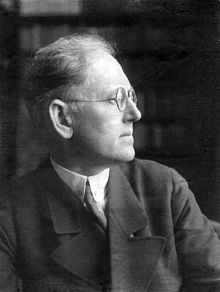Paul Schultze-Naumburg (10 June 1869 – 19 May 1949) was a Nazi architect and one of Nazi Germany's most vocal political critics of modern architecture. Along with Alexander von Senger, Eugen Honig, Konrad Nonn, and German Bestelmeyer, Schultze-Naumburg was a member of a National Socialist para-governmental propaganda unit called the Kampfbund deutscher Architekten und Ingenieure (KDAI). [citation needed]

Leben
Schultze-Naumburg was born in Almrich (now part of Naumburg) in Prussian Saxony, and by 1900 was a well-known painter and architect, first emerging as a more-conservative member of the group of artists who established the Jugendstil and the Arts and Crafts workshops in Munich. His series of books the Kulturarbeiten ("Works of Culture"), nine volumes published 1900-1917, were extremely popular and established him as a major tastemaker for the German middle class. By the First World War, he had become a major proponent of traditional architecture, an originator of the "Circa 1800" movement, and an important voice in both the Deutsche Werkbund and the nationalist German architecture and landscape preservation movement. A well-known example of his architecture from this time is the Cecilienhof Palace in Potsdam, built for crown prince Wilhelm, 1914-1917.
In response to the defeat of the First World War and of his own marginalization in the interwar architectural discourse, Schultze-Naumburg's articles and books began to take on a far harsher and less progressive character, condemning modern art and architecture in racial terms, thereby providing much of the basis for Adolf Hitler's theories in which classical Greece and the Middle Ages were the true sources of Aryan art.[1]Schultze-Naumburg wrote such books as Die Kunst der Deutschen. Ihr Wesen und ihre Werke ("The Art of the Germans. Their Nature and Their Factories") and Kunst und Rasse ("Art and Race"), the latter published in 1928, in which he argued that only "racially pure" artists could produce a healthy art which upheld timeless ideals of classical beauty, while racially "mixed" modern artists showed their inferiority and corruption by producing distorted artwork. As evidence of this, he reproduced examples of modern art next to photographs of people with deformities and diseases, graphically reinforcing the idea of modernism as a sickness.[2]
In September 1944, he was named as one of the first rank of artists and writers important to Nazi culture in the Gottbegnadeten list.
Schultze-Naumburg died in Jena in 1949.
Bibliography
- Jose-Manuel GARCÍA ROIG, "Tres arquitectos del periodo guillermino. Hermman Muthesius. Paul Schultze-Naumburg. Paul Mebes", Valladolid (Spain), 2006, ISBN 978-84-8448-370-0, Universidad de Valladolid, Spain
References
Notes
Sources
- Adam, Peter. Art of the Third Reich (1992). New York: Harry N. Abrams, Inc.. ISBN 0-8109-1912-5
- Barron, Stephanie, ed. 'Degenerate Art:' The Fate of the Avant-Garde in Nazi Germany (1991). New York: Harry N. Abrams, Inc.. ISBN 0-8109-3653-4
- Grosshans, Henry. Hitler and the Artists (1983). New York: Holmes & Meyer. ISBN 0-8419-0746-3